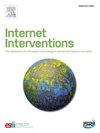Sine of the times: Can sinusoidal waves model changes in the therapeutic alliance over time?
IF 4.1
2区 医学
Q1 HEALTH CARE SCIENCES & SERVICES
Internet Interventions-The Application of Information Technology in Mental and Behavioural Health
Pub Date : 2025-06-23
DOI:10.1016/j.invent.2025.100845
引用次数: 0
Abstract
The present study examined the association between the therapeutic alliance and social anxiety symptoms during internet-delivered cognitive behavior therapy (ICBT) for social anxiety disorder (SAD). We examined 162 individuals diagnosed with SAD who underwent therapist-assisted ICBT and completed measures of the therapeutic alliance weekly during a randomized controlled trial. We used a novel modeling strategy and modeled changes in the therapeutic alliance over time using sinusoidal models. We found that a model that incorporated both a linear component and a sinusoidal component (r2 = 0.72), explained significantly more variance than models using only linear (r2 = 0.42) or only sinusoidal (r2 = 0.41) components. We also found that higher average levels of the alliance as well as greater increases in the therapeutic alliance during treatment were associated with greater reductions in social anxiety during treatment. Finally, we found that greater fluctuations around the slope of alliance were associated with greater reductions in social anxiety during treatment (above and beyond average alliance and increases in alliance). Considering fluctuations around a linear slope may be a useful model for the ups and downs experienced in the therapeutic alliance over the course of therapy. Fluctuations in alliance may not be a sign of negative processes, but could potentially indicate a healthy ebb and flow of the alliance that is predictive of better outcomes.
正弦波:正弦波是否可以模拟治疗联盟随时间的变化?
本研究旨在探讨网络认知行为疗法(ICBT)治疗社交焦虑障碍(SAD)过程中治疗联盟与社交焦虑症状的关系。在一项随机对照试验中,我们检查了162名被诊断为SAD的患者,他们接受了治疗师辅助的ICBT,并每周完成治疗联盟的测量。我们使用了一种新的建模策略,并使用正弦模型模拟了治疗联盟随时间的变化。我们发现,与仅使用线性(r2 = 0.42)或仅使用正弦(r2 = 0.41)成分的模型相比,同时包含线性成分和正弦成分的模型(r2 = 0.72)可以解释更多的方差。我们还发现,在治疗期间,更高的联盟平均水平以及治疗联盟的更大增长与治疗期间社交焦虑的更大减少有关。最后,我们发现,在治疗期间,围绕联盟斜率的较大波动与社交焦虑的较大减少有关(高于和超过平均联盟,联盟增加)。考虑围绕线性斜率的波动可能是治疗联盟在治疗过程中经历的起伏的有用模型。联盟的波动可能不是消极进程的标志,但可能潜在地表明联盟的健康起起落落,预示着更好的结果。
本文章由计算机程序翻译,如有差异,请以英文原文为准。
求助全文
约1分钟内获得全文
求助全文
来源期刊

Internet Interventions-The Application of Information Technology in Mental and Behavioural Health
Medicine-Health Informatics
CiteScore
6.50
自引率
9.30%
发文量
94
审稿时长
6 weeks
期刊介绍:
Official Journal of the European Society for Research on Internet Interventions (ESRII) and the International Society for Research on Internet Interventions (ISRII).
The aim of Internet Interventions is to publish scientific, peer-reviewed, high-impact research on Internet interventions and related areas.
Internet Interventions welcomes papers on the following subjects:
• Intervention studies targeting the promotion of mental health and featuring the Internet and/or technologies using the Internet as an underlying technology, e.g. computers, smartphone devices, tablets, sensors
• Implementation and dissemination of Internet interventions
• Integration of Internet interventions into existing systems of care
• Descriptions of development and deployment infrastructures
• Internet intervention methodology and theory papers
• Internet-based epidemiology
• Descriptions of new Internet-based technologies and experiments with clinical applications
• Economics of internet interventions (cost-effectiveness)
• Health care policy and Internet interventions
• The role of culture in Internet intervention
• Internet psychometrics
• Ethical issues pertaining to Internet interventions and measurements
• Human-computer interaction and usability research with clinical implications
• Systematic reviews and meta-analysis on Internet interventions
 求助内容:
求助内容: 应助结果提醒方式:
应助结果提醒方式:


